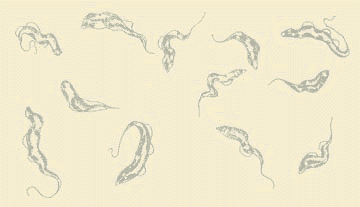

 |
 |
|||
| Plasmid details and downloadable files (click here for cre-lox systems) | |||||
Use the links in the main menu (above) for general advice on genetics (including RNAi) or the cre-lox systems. Some of our key expression plasmids and cell lines are described in publications by Wirtz 1998 and 1999, Patnaik 1993, and Leal 2004. After they became more widely used, it became apparent from re-sequencing by ourselves and others that the sequences of some segments in plasmids made by Liz Wirtz and in Christine Clayton's lab had not been verified. Presumably it had been assumed that sequences obtained from GenBank or other sources matched the ones that were actually used. We do know that these constructs all work as intended. Errors are corrected as we become aware of them (missing restriction sites or some that were not known to be present based on the sequence, for example). Please e-mail me if you find further discrepancies. As I always tell people in my lab, if the presence or absence of a restriction site is critical to your planning, check by digesting the plasmid yourself before proceeding. We have made (unpublished except on this web site or incidentally in some of our papers) improvements to the original pLEW82 and pLEW100 vectors: pLEW100 versions using a rRNA promoter, with 3 Tet operators and 2 T7 terminators, give efficient integration and high level highly regulated expression, especially in bloodstream forms, and pLEW82v4 allows selection for integration without requiring tetracycline induction. If you want lower expression levels in bloodstream forms you should use the original pLEW100 with the Procyclin GPEET promoter. For procyclic forms, either the Procyclin or rRNA promoter give similar expression levels but the pLEW100 rRNA promoter version has other improvements (see notes below). pLEW82 and pUB39 give the highest expression levels in either life-cycle stage, but at the expense of poor regulation (the background level is about 5% of the maximum induced level). In general, the expression vectors require the luciferase gene to be removed and your gene of interest to be inserted by cutting with HindIII and BamHI. The Hind-Bam fragment in most constructs here and elsewhere contains an extraneous 39-bp upstream CDS that reduces luciferase expression about 8-fold (Siegel, Tan & Cross, 2002 DOI). Click the plasmid name to view or download a full-page illustration in pdf format. Illustrations show (in red) enzymes that are predicted to cut once. Other enzymes are shown that are relevant to the particular use of the plasmid. Right click (PC and Mac) or control click (Mac) the appropriate icon to download sequence files (sbd or gbk). Click the WORD icon to open the GenBank-formatted file in a new window. This page was very labor intensive to develop, so please inform me if any of the links give you the wrong files, or if you encounter any other problems. The plasmids are listed by functional groups rather than by number and the most useful are highlighted with a green background. Most are based on a pGEM4 backbone and are designed to target an rRNA spacer locus after linearization with NotI (the NotI site was introduced into the rRNA spacer sequence). There are 9 target sequences in the TREU 927 genome (one each on Chr 1 and 7, 3 on Chr 2, and 5 on Chr 3) but the numbers could differ in Lister 427 (and in other strains). The number of TUBULIN genes in the tandem repeat on Chr 1 is uncertain and probably is different between 927 and 427. Funny things can happen when targeting the TUBULIN array! It is not a stable place to insert genes, for obvious reasons. | |||||
|
To ensure continued availability of our most frequently requested plasmids, as my lab winds down, we have deposited them with Addgene. Please use the link to the left to check availability and request them. |
| PLASMID NAME | Lasergene Seqbuilder | GenBank (text) | TARGET LOCUS |
MAIN FEATURES | SELECTION | RELEVANT PROMOTER |
REGULATION |
| Constructs for making inducible cell lines | |||||||
| pLEW13 | Tubulin | T7 RNA Polymerase and Tet Repressor. See important footnotes about T7RNAP and TetR sequences * ** | G418 | Readthrough | None | ||
| pLEW29 | RNA Pol I | Tet Repressor driven by a 10% T7 promoter ** | Hygromycin | 10% T7 | None | ||
| pLEW90 | Tubulin | Tet Repressor driven by a 10% T7 promoter ** | Hygromycin | 10% T7 | None | ||
| pHD328 | Tubulin | T7 RNA Polymerase * | Hygromycin | Readthrough | None | ||
| pLEW114-HYG5' | pHD328 | Tet Repressor driven by a 10% T7 promoter ** | G418 | 10% T7 | None | ||
| Vectors for inducible gene expression | |||||||
| pLEW82 | rRNA spacer | Single T7 promoter drives luciferase and drug resistance.High expression with poor regulation. pLEW82v4 replaces this original high-expression vector. | Phleomycin | T7 | 1 tet Op 2 T7 terminators | ||
| pLEW82v4 | rRNA spacer | Added a constitutive 10% T7p to drive BLE, 3 Tet operators to the T7 promoter, and revised sites for cloning reporter genes. High expression but still disappointingly poor regulation. | Phleomycin | T7 | 3 tet Op 2 T7 terminators | ||
| pLEW82v5-trunc | rRNA spacer | Has a regulated truncated cytoplasmic luciferase CDS and no 10% T7 promoter. | Phleomycin | T7 | 3 tet Op 2 T7 terminators | ||
| pLEW20 | rRNA spacer | Like pLEW82 but a GPEET promoter drives Luciferase and BLE. | Phleomycin | GPEET | 2 tet operators | ||
| pLEW111 | rRNA spacer | pLEW111 is pLEW82 after removing Luciferase. For information only. | Phleomycin | T7 | 1 tet Op 2 T7 terminators | ||
| pLEW111-BSD-(pFlan1) | rRNA spacer | pLEW111 (pLEW82) with BSD instead of BLE. | Blasticidin | T7 | 1 tet Op 2 T7 terminators | ||
| IMPORTANT NOTE (September 15th 2008): the PvuII site shown at the top of the pLEW100-series plasmids is not present. The sequences will be corrected asap. | |||||||
| pLEW100 | rRNA spacer | Original dual promoter expression vector. Unregulated T7p drives BLE: regulated GPEETp drives luciferase. All the pLEW100 series give excellent regulation but the following are better general-purpose versions. | Phleomycin | GPEET | 2 tet Op | ||
| pLEW100v5 | rRNA spacer | T7 terminators added: regulated rRNAp drives luciferase, giving about 10-fold higher te-induced expression in BF than pLEW100 with no increase in background. *** | Phleomycin | rRNA | 2 tet Op 2 T7 terminators | ||
| pLEW100v5-HYG | rRNA spacer | As above but with hygromycin in place of phleomycin. | Hygromycin | rRNA | 2 tet Op 2 T7 terminators | ||
| pLEW100v5-BSD | rRNA spacer | As above but with blasticidin in place of phleomycin. | Blasticidin | rRNA | 2 tet Op 2 T7 terminators | ||
| pLEW100v5-177-HYG | 177-bp rep | As above but targeted to 177-bp repeats. | Hygromycin | rRNA | 2 tet Op 2 T7 terminators | ||
| pLEW100v5-trunc | rRNA spacer | Has a regulated truncated cytoplasmic luciferase CDS. | Phleomycin | rRNA | 2 tet Op 2 T7 terminators | ||
| pLEW100v6-HYG | rRNA spacer | A constitutive GPEET promoter replaces T7 promoter to drive HYG. Hypothetical: not available due to expression problems. | Hygromycin | rRNA | 2 tet Op 2 T7 terminators | ||
| pHD309-HYG-PUR | B-Tubulin | Allows genes to be cloned into the tubulin array. Remove PUR and replace it with your gene of interest. | Hygromycin | Readthrough | None | ||
Tagging vectors We have other ad hoc tagging vectors but other labs have a wide repertoire that we also use (see information on the genetics introduction page). |
|||||||
| pCO57 | rRNA spacer | pLEW82 background allows eGFP fusion to C terminus of desired protein. | Phleomycin | T7 | 2 tet Op 4 T7 terminators | ||
| pJEL61 | rRNA spacer | pLEW82 background for C-terminal eYFP fusion at one of several restriction sites. | Phleomycin | T7 | 1 tet Op 2 T7 terminators | ||
| Miscellaneous | |||||||
| p2T7TAblue | rRNA spacer | Preferred 'easy-RNAi' vector from David Horn. The formatted sequence is provided here as a convenience only. | Hygromycin | 2 T7 | 1 tet Op 2 T7 terminators | ||
| pUB39 | rRNA spacer | pLEW82 with VSG 117 cDNA insert that can be replaced with your gene to give maximum attainable expression but poor regulation **** | Phleomycin | T7 | 1 tet Op 2 T7 terminators | ||
| pT13-11 episome | Episomal | A stable (with selection) episome for various purposes in procyclic forms | G418 | GPEET | Not regulated | ||
| pT11-bs episome | Episomal | A still problematic version of pT13-11 for bloodstream forms | G418 | GPEET | Not regulated | ||
|
* The pLEW13 and pHD328 T7 RNA Polymerase sequences were corrected on 13th July 1999. The previously circulated files showed an incorrrect NLS sequence in the T7RNAP, and other minor errors in the T7RNAP 5' flanking sequence. The NLS error had been perpetuated unknowingly for several years, and we thank Dan Ray (UCLA) for reporting it. Both constructs have the original SV40 T-antigen nuclear localization signal as correctly stated in Wirtz, Hartmann and Clayton (1994) Nucleic Acids Res 22:3887-94: only the original sequence files were incorrect. IMPORTANT: the T7RNAP sequence was further corrected in October 2009 based on actual sequencing in (unpublished) ZM construct (formally 'pyrFEKO-HYG tetr-t7rnap actual correct'), which matches updated 2009 sequence in GenBank (FJ881694). ** We were alerted in October 2007 by Michal Swiderski (Glasgow), there were extra EcoRI and Bam sites in pLEW29. We also heard (and found ourselves) that the Tet repressor could not be amplified with flanking PCR primers designed according to the published sequence. We re-sequenced the entire insert from position 6796 to 3808 in November 2007. There were a few insertions in the upstream flanking sequence and 3 amino acid changes in the TetR CDS (correcting these gives a 100% match with sequences in GenBank: an erroneous sequence was possibly used in the original 'theoretical plasmid' constructs), but the main differences was that, immediately downstream of the tetR CDS, there was an extra ~90 bp region of the 260-bp ACTIN 3' UTR that was not in the original or the previously 'corrected' pLEW29 versions. The downstream was also corrected in the pLEW13 sequence and the CDS corrections were made in all 4 listed plasmids containing the TetR. The Wirtz 1999 paper says plasmid was cut with NotI and SspI prior to transfection (NotI and PmlI would look like a better choice, assuming the PmlI site is also unique. *** Because of the lack of restriction sites flanking target and marker (they were lost during the original construction) the new pLEW100 derivatives could not easily have been made without the assistance of Jane Scocca (Johns Hopkins School of Medicine) who had made some pLEW100 derivatives in which she had introduced the necessary restriction sites. We are grateful to Jane for providing these to us in 2005. **** pUB39 is derived from pLEW82. It contains the VSG117 coding sequence between HindIII and BamHI cloning sites but has additional VSG cDNA-derived UTR sequences that result in 2 to 3-fold higher expression than from pLEW82. This is the highest level of expression currently available in bloodstream trypanosomes. |
|||||||